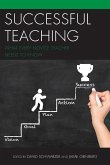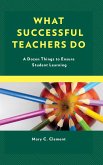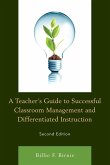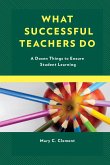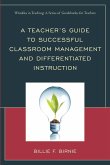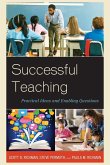Successful Teaching
What Every Novice Teacher Needs to Know
Herausgeber: Schwarzer, David; Grinberg, Jamie
Successful Teaching
What Every Novice Teacher Needs to Know
Herausgeber: Schwarzer, David; Grinberg, Jamie
- Gebundenes Buch
- Merkliste
- Auf die Merkliste
- Bewerten Bewerten
- Teilen
- Produkt teilen
- Produkterinnerung
- Produkterinnerung
This edited volume provides novice teachers with a practical guide to help them transition from teacher education students to independent, reflective and autonomous classroom teachers.
Andere Kunden interessierten sich auch für
![Successful Teaching Successful Teaching]() Successful Teaching58,99 €
Successful Teaching58,99 €![What Successful Teachers Do What Successful Teachers Do]() Mary C. ClementWhat Successful Teachers Do77,99 €
Mary C. ClementWhat Successful Teachers Do77,99 €![Teacher's Guide to Successful Classroom Management and Differentiated Instruction Teacher's Guide to Successful Classroom Management and Differentiated Instruction]() Billie F. BirnieTeacher's Guide to Successful Classroom Management and Differentiated Instruction23,99 €
Billie F. BirnieTeacher's Guide to Successful Classroom Management and Differentiated Instruction23,99 €![What Successful Teachers Do What Successful Teachers Do]() Mary C. ClementWhat Successful Teachers Do42,99 €
Mary C. ClementWhat Successful Teachers Do42,99 €![Teacher's Guide to Successful Classroom Management and Differentiated Instruction Teacher's Guide to Successful Classroom Management and Differentiated Instruction]() Billie F. BirnieTeacher's Guide to Successful Classroom Management and Differentiated Instruction21,99 €
Billie F. BirnieTeacher's Guide to Successful Classroom Management and Differentiated Instruction21,99 €![How to Have a Successful Freelance Education Career How to Have a Successful Freelance Education Career]() Fe LutonHow to Have a Successful Freelance Education Career166,99 €
Fe LutonHow to Have a Successful Freelance Education Career166,99 €![Successful Teaching Successful Teaching]() Scott D. RichmanSuccessful Teaching61,99 €
Scott D. RichmanSuccessful Teaching61,99 €-
-
-
This edited volume provides novice teachers with a practical guide to help them transition from teacher education students to independent, reflective and autonomous classroom teachers.
Produktdetails
- Produktdetails
- Verlag: Rowman & Littlefield Publishers
- Seitenzahl: 350
- Erscheinungstermin: 20. Dezember 2016
- Englisch
- Abmessung: 235mm x 157mm x 25mm
- Gewicht: 719g
- ISBN-13: 9781475825282
- ISBN-10: 1475825285
- Artikelnr.: 45641834
- Herstellerkennzeichnung
- Libri GmbH
- Europaallee 1
- 36244 Bad Hersfeld
- gpsr@libri.de
- Verlag: Rowman & Littlefield Publishers
- Seitenzahl: 350
- Erscheinungstermin: 20. Dezember 2016
- Englisch
- Abmessung: 235mm x 157mm x 25mm
- Gewicht: 719g
- ISBN-13: 9781475825282
- ISBN-10: 1475825285
- Artikelnr.: 45641834
- Herstellerkennzeichnung
- Libri GmbH
- Europaallee 1
- 36244 Bad Hersfeld
- gpsr@libri.de
David Schwarzer is a Full Professor in the Department of Secondary and Special Education at Montclair State University.. His areas of expertise are multilingual education, translingualism, and international perspectives in teacher education. Jaime Grinberg is Full Professor and Chairperson of the Department of Educational Foundations at Montclair State University. His research and writings have focused on educational progressivism; teacher preparation; as well as historical, political and cultural studies in education.
Acknowledgments
Introduction
David Schwarzer and Jaime Grinberg
Section I - Getting to Know Your Students, Families, and Communities
Chapter 1: Connecting Students' Cultural Expressions to the Curriculum
Danne Davis
Chapter 2: It Takes a Village: Families, Contexts, and Diversity
Katia Goldfarb, Jaime Grinberg, and Sejal Rana
Chapter 3: Shifting the Locus of Control: Five Strategies for Creating a
21st Century Student Centered Classroom
Mayida Zaal & Maheen Ahmad
Chapter 4: Keys to Accessible Instruction for Students with Disabilities
Jennifer Goeke, Pohun Chen, and Niobel Torres
Chapter 5: Planning Instructions for English Learners: Strategies Teachers
Need to Know
Mayra C. Daniel
Section II - Curriculum Development
Chapter 6: Engaging Students through Interdisciplinary Lessons and Units
Sandra Rodriguez-Arroyo and Melanie Bloom
Chapter 7: Shaping Effective Learning Through Student Engagement
Susan Wray
Chapter 8: Developing Academic Literacy: What Novice Teachers Can Learn
from the Case of Teaching Latino/Bilingual Learners Science and Mathematics
Sandra Musanti and Sandra Mercuri
Chapter 9: Using Traditional Assessments to Effectively Inform Your
Teaching
Nicole Barnes and Charity Dacey
Chapter 10: Authentic Performance Assessments
Charity Dacey and Nicole Barnes
Chapter 11: Making "IT" Meaningful: Intentional Technology Integration
through TPACK
Christopher Luke
Section III - Pedagogical Decisions
Chapter 12: No One Gets Left Behind: Grouping Students with Intention,
Skill, and Responsiveness
David Keiser and Anne Lockwood
Chapter 13: Developing, Implementing, and Assessing Problem Based Learning
Stephanie Curtis, Joseph DiGiacomo, and Vincent Walencik
Chapter 14: Creating a Dialogical Learning Community to Promote Dialogical
Teaching and Learning
Jaime Grinberg, David Schwarzer, and Michael Molino
Chapter 15: Fostering a Scientific Approach to Teaching and Learning:
Deductive and Inductive Teaching
Helenrose Fives and Melissa Susnosky
Chapter 16: Collaboration in the Inclusive Classroom
Jennifer Goeke, Pohun Chen, and Niobel Torres
Section IV - Putting it All Together
Chapter 17: "Where do I start?" - Guiding Novice Teachers to Improve Their
Practice Through Self-Reflection and Action Research
Mary Petron and Barburhan Uzum
Afterword: Using the Master Checklist in a Masterful Way
David Schwarzer
About the Editors
About the Contributors
Introduction
David Schwarzer and Jaime Grinberg
Section I - Getting to Know Your Students, Families, and Communities
Chapter 1: Connecting Students' Cultural Expressions to the Curriculum
Danne Davis
Chapter 2: It Takes a Village: Families, Contexts, and Diversity
Katia Goldfarb, Jaime Grinberg, and Sejal Rana
Chapter 3: Shifting the Locus of Control: Five Strategies for Creating a
21st Century Student Centered Classroom
Mayida Zaal & Maheen Ahmad
Chapter 4: Keys to Accessible Instruction for Students with Disabilities
Jennifer Goeke, Pohun Chen, and Niobel Torres
Chapter 5: Planning Instructions for English Learners: Strategies Teachers
Need to Know
Mayra C. Daniel
Section II - Curriculum Development
Chapter 6: Engaging Students through Interdisciplinary Lessons and Units
Sandra Rodriguez-Arroyo and Melanie Bloom
Chapter 7: Shaping Effective Learning Through Student Engagement
Susan Wray
Chapter 8: Developing Academic Literacy: What Novice Teachers Can Learn
from the Case of Teaching Latino/Bilingual Learners Science and Mathematics
Sandra Musanti and Sandra Mercuri
Chapter 9: Using Traditional Assessments to Effectively Inform Your
Teaching
Nicole Barnes and Charity Dacey
Chapter 10: Authentic Performance Assessments
Charity Dacey and Nicole Barnes
Chapter 11: Making "IT" Meaningful: Intentional Technology Integration
through TPACK
Christopher Luke
Section III - Pedagogical Decisions
Chapter 12: No One Gets Left Behind: Grouping Students with Intention,
Skill, and Responsiveness
David Keiser and Anne Lockwood
Chapter 13: Developing, Implementing, and Assessing Problem Based Learning
Stephanie Curtis, Joseph DiGiacomo, and Vincent Walencik
Chapter 14: Creating a Dialogical Learning Community to Promote Dialogical
Teaching and Learning
Jaime Grinberg, David Schwarzer, and Michael Molino
Chapter 15: Fostering a Scientific Approach to Teaching and Learning:
Deductive and Inductive Teaching
Helenrose Fives and Melissa Susnosky
Chapter 16: Collaboration in the Inclusive Classroom
Jennifer Goeke, Pohun Chen, and Niobel Torres
Section IV - Putting it All Together
Chapter 17: "Where do I start?" - Guiding Novice Teachers to Improve Their
Practice Through Self-Reflection and Action Research
Mary Petron and Barburhan Uzum
Afterword: Using the Master Checklist in a Masterful Way
David Schwarzer
About the Editors
About the Contributors
Acknowledgments
Introduction
David Schwarzer and Jaime Grinberg
Section I - Getting to Know Your Students, Families, and Communities
Chapter 1: Connecting Students' Cultural Expressions to the Curriculum
Danne Davis
Chapter 2: It Takes a Village: Families, Contexts, and Diversity
Katia Goldfarb, Jaime Grinberg, and Sejal Rana
Chapter 3: Shifting the Locus of Control: Five Strategies for Creating a
21st Century Student Centered Classroom
Mayida Zaal & Maheen Ahmad
Chapter 4: Keys to Accessible Instruction for Students with Disabilities
Jennifer Goeke, Pohun Chen, and Niobel Torres
Chapter 5: Planning Instructions for English Learners: Strategies Teachers
Need to Know
Mayra C. Daniel
Section II - Curriculum Development
Chapter 6: Engaging Students through Interdisciplinary Lessons and Units
Sandra Rodriguez-Arroyo and Melanie Bloom
Chapter 7: Shaping Effective Learning Through Student Engagement
Susan Wray
Chapter 8: Developing Academic Literacy: What Novice Teachers Can Learn
from the Case of Teaching Latino/Bilingual Learners Science and Mathematics
Sandra Musanti and Sandra Mercuri
Chapter 9: Using Traditional Assessments to Effectively Inform Your
Teaching
Nicole Barnes and Charity Dacey
Chapter 10: Authentic Performance Assessments
Charity Dacey and Nicole Barnes
Chapter 11: Making "IT" Meaningful: Intentional Technology Integration
through TPACK
Christopher Luke
Section III - Pedagogical Decisions
Chapter 12: No One Gets Left Behind: Grouping Students with Intention,
Skill, and Responsiveness
David Keiser and Anne Lockwood
Chapter 13: Developing, Implementing, and Assessing Problem Based Learning
Stephanie Curtis, Joseph DiGiacomo, and Vincent Walencik
Chapter 14: Creating a Dialogical Learning Community to Promote Dialogical
Teaching and Learning
Jaime Grinberg, David Schwarzer, and Michael Molino
Chapter 15: Fostering a Scientific Approach to Teaching and Learning:
Deductive and Inductive Teaching
Helenrose Fives and Melissa Susnosky
Chapter 16: Collaboration in the Inclusive Classroom
Jennifer Goeke, Pohun Chen, and Niobel Torres
Section IV - Putting it All Together
Chapter 17: "Where do I start?" - Guiding Novice Teachers to Improve Their
Practice Through Self-Reflection and Action Research
Mary Petron and Barburhan Uzum
Afterword: Using the Master Checklist in a Masterful Way
David Schwarzer
About the Editors
About the Contributors
Introduction
David Schwarzer and Jaime Grinberg
Section I - Getting to Know Your Students, Families, and Communities
Chapter 1: Connecting Students' Cultural Expressions to the Curriculum
Danne Davis
Chapter 2: It Takes a Village: Families, Contexts, and Diversity
Katia Goldfarb, Jaime Grinberg, and Sejal Rana
Chapter 3: Shifting the Locus of Control: Five Strategies for Creating a
21st Century Student Centered Classroom
Mayida Zaal & Maheen Ahmad
Chapter 4: Keys to Accessible Instruction for Students with Disabilities
Jennifer Goeke, Pohun Chen, and Niobel Torres
Chapter 5: Planning Instructions for English Learners: Strategies Teachers
Need to Know
Mayra C. Daniel
Section II - Curriculum Development
Chapter 6: Engaging Students through Interdisciplinary Lessons and Units
Sandra Rodriguez-Arroyo and Melanie Bloom
Chapter 7: Shaping Effective Learning Through Student Engagement
Susan Wray
Chapter 8: Developing Academic Literacy: What Novice Teachers Can Learn
from the Case of Teaching Latino/Bilingual Learners Science and Mathematics
Sandra Musanti and Sandra Mercuri
Chapter 9: Using Traditional Assessments to Effectively Inform Your
Teaching
Nicole Barnes and Charity Dacey
Chapter 10: Authentic Performance Assessments
Charity Dacey and Nicole Barnes
Chapter 11: Making "IT" Meaningful: Intentional Technology Integration
through TPACK
Christopher Luke
Section III - Pedagogical Decisions
Chapter 12: No One Gets Left Behind: Grouping Students with Intention,
Skill, and Responsiveness
David Keiser and Anne Lockwood
Chapter 13: Developing, Implementing, and Assessing Problem Based Learning
Stephanie Curtis, Joseph DiGiacomo, and Vincent Walencik
Chapter 14: Creating a Dialogical Learning Community to Promote Dialogical
Teaching and Learning
Jaime Grinberg, David Schwarzer, and Michael Molino
Chapter 15: Fostering a Scientific Approach to Teaching and Learning:
Deductive and Inductive Teaching
Helenrose Fives and Melissa Susnosky
Chapter 16: Collaboration in the Inclusive Classroom
Jennifer Goeke, Pohun Chen, and Niobel Torres
Section IV - Putting it All Together
Chapter 17: "Where do I start?" - Guiding Novice Teachers to Improve Their
Practice Through Self-Reflection and Action Research
Mary Petron and Barburhan Uzum
Afterword: Using the Master Checklist in a Masterful Way
David Schwarzer
About the Editors
About the Contributors



